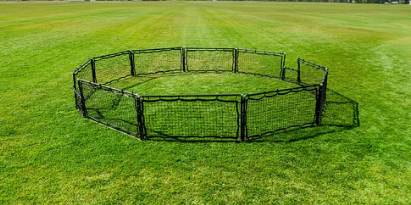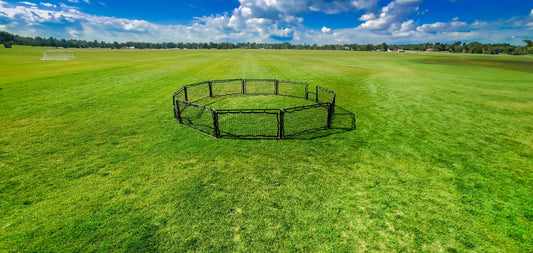Greetings, fellow soccer enthusiasts! If you've ever dreamed of bending it like Beckham, dribbling like Messi, or defending like Rapinoe, you're in for a treat. We're about to dive into the world of soccer training equipment—a realm where cones become your allies, agility ladders turn into dance floors, and the humble soccer ball transforms into your ticket to glory. So lace up those boots, grab your sense of humor (and maybe a shin guard or two), because we're about to embark on a journey through the tools that turn casual players into soccer sorcerers. Get ready to kick, sprint, and laugh your way to soccer superstardom!

Soccer, known as football in most parts of the world, is a widely popular sport played between two teams, each consisting of 11 players. The game is played on a rectangular field with goals at each end. The primary objective is to score goals by propelling a spherical ball into the opponent's goal using any part of the body except the hands and arms (excluding the goalkeeper within their penalty area).
Key Elements of Soccer:
- The Field: A soccer field, often referred to as a pitch, is a rectangular playing surface with markings for the penalty area, goal area, center circle, and other features.
- Teams: Each team has 11 players, including one goalkeeper. Players are assigned various positions, such as forwards, midfielders, defenders, and the goalkeeper, each with specific roles and responsibilities.
- The Ball: Soccer is played with a round ball, typically made of leather or other suitable materials. The standard size and weight of the ball are specified by soccer regulations.
- Goals: The objective is to score goals by kicking or heading the ball into the opponent's goal. The entire ball must cross the goal line between the goalposts and beneath the crossbar for a goal to be counted.
- Duration of Play: A standard soccer match consists of two halves, each lasting 45 minutes. In some cases, additional time may be added for stoppages or extra time in knockout stages of competitions.
- Offside Rule: The offside rule restricts attacking players from being in an offside position (closer to the opponent's goal line than both the ball and the second-to-last defender) when the ball is played to them.
- Fouls and Free Kicks: Fouls committed by players result in free kicks or penalty kicks for the opposing team, depending on the location and severity of the foul.
- Throw-ins: When the ball goes out of play over the touchline, it is put back into play with a throw-in. The player must use both hands and keep both feet on or behind the touchline.
- Corner Kicks: If the defending team is the last to touch the ball before it crosses their own goal line, the opposing team is awarded a corner kick. The ball is placed in the corner arc for a player to kick.
- Goal Kicks: When the attacking team is the last to touch the ball before it crosses the goal line, the defending team is awarded a goal kick. The ball is kicked from the goal area by a defending player.
Soccer is renowned for its simplicity, requiring only a ball and a field, yet it demands skill, strategy, teamwork, and athleticism from its players. It is the world's most popular sport, with a massive global following and a rich history of competitions at both domestic and international levels.
Below we are going to discuss some different types of equipment and how they can assist in your soccer skills.
Coaching Sticks
Coaching sticks are valuable tools in soccer training, serving various purposes to enhance players' skills and overall performance. Here are several ways coaching sticks assist in soccer training:
- Agility and Footwork:
- Coaching sticks can be arranged in patterns to create agility drills. Players navigate through the sticks, improving their footwork, balance, and agility. This helps enhance a player's ability to change direction quickly and with control.
- Dribbling Drills:
- Placing coaching sticks in specific configurations or distances requires players to perform dribbling maneuvers with precision. This helps players develop close ball control, improve their touch, and enhance their ability to maneuver around opponents.
- Obstacle Courses:
- By setting up coaching sticks as obstacles, coaches can design challenging courses for players to navigate. This encourages quick decision-making, spatial awareness, and the development of creative solutions to navigate through tight spaces.
- Defensive Training:
- Coaching sticks can simulate defensive scenarios. Defenders can practice marking and closing down opponents by maneuvering around the sticks, improving their ability to intercept passes and disrupt the opposition's attacking plays.
- Shooting Accuracy:
- Placing coaching sticks within the goal area or creating target zones helps players refine their shooting accuracy. Strikers can practice precision shots by aiming for specific areas, simulating real game scenarios where they need to place the ball away from the goalkeeper or defenders.
- Heading Practice:
- Coaching sticks can be used to set up drills for heading practice. Players can work on heading the ball over or around the sticks, improving their timing, technique, and aerial ability.
- Spatial Awareness:
- Utilizing coaching sticks helps players develop spatial awareness, understanding the positioning of themselves, teammates, and opponents. This is crucial for making effective passes, finding open spaces, and maintaining positional discipline on the field.
- Set-Piece Training:
- Coaches can use coaching sticks to outline set-piece strategies during training sessions. This includes indicating player positions during free kicks, corners, or throw-ins, allowing players to practice their movements and execute set plays effectively.
- Communication Training:
- Incorporating coaching sticks into training scenarios encourages communication among players. They can use the sticks as reference points to coordinate movements, plan strategies, and improve team communication on the field.
- Injury Prevention:
- Coaching sticks can also serve as markers for specific exercises aimed at injury prevention. Players can use them as reference points for warm-up drills and dynamic stretching routines.
In summary, coaching sticks are versatile training tools that contribute to various aspects of soccer development. They enhance players' technical skills, physical attributes, and tactical understanding, making them valuable assets in soccer training sessions.
Rebounders

Rebounders are valuable tools in soccer training, providing players with a versatile and dynamic platform to enhance various skills. Here are several ways rebounders assist in soccer training:
- Passing Accuracy:
- Rebounders allow players to practice passing accuracy. By passing the ball into the rebounder and controlling the return, players can refine their passing technique, both with the instep and other surfaces of the foot.
- First Touch and Ball Control:
- Rebounders help improve a player's first touch and ball control. Players can receive the ball from the rebounder and work on controlling it with different parts of their body, such as the instep, thigh, or chest.
- Volleying and Half-Volleying:
- Volleying and half-volleying are crucial skills in soccer. Rebounders provide a consistent and controlled environment for players to practice striking the ball in the air. This enhances their ability to time and connect with volleys and half-volleys.
- Shooting Technique:
- Rebounders are effective for shooting practice. Players can strike the ball into the rebounder and receive it back at varying angles and speeds, allowing them to work on their shooting technique, power, and accuracy.
- Heading Drills:
- Rebounders with a suitable design can facilitate heading drills. Players can direct the ball accurately with their head towards the rebounder, simulating scenarios where heading precision is crucial in a game.
- One-Touch Passing:
- Rebounders are excellent for practicing one-touch passing. Players can quickly play the ball into the rebounder and then receive it back with a single touch, promoting rapid ball circulation and improving decision-making.
- Aerial Control:
- Rebounders can be adjusted to different angles to simulate aerial challenges. Players can practice controlling the ball in the air, enhancing their ability to win headers and bring the ball under control when it's played at varying heights.
- Goalkeeper Training:
- Goalkeepers can use rebounders to practice shot-stopping and distribution. Receiving shots from the rebounder helps goalkeepers work on their reflexes, positioning, and ability to deal with shots from different angles.
- Reaction Time:
- Rebounders add an element of unpredictability to training sessions, requiring players to react quickly to the ball's return. This improves their reaction time and adaptability during fast-paced game situations.
- Fitness and Conditioning:
- Incorporating rebounders into training drills can also contribute to players' fitness and conditioning. The continuous movement and quick reactions required during rebounder exercises contribute to cardiovascular fitness and agility.
- Solo Training:
- Rebounders are excellent for solo training, allowing players to work on their skills independently. This makes them versatile tools for individual practice sessions.
In summary, rebounders are versatile training aids that contribute to various aspects of soccer development. They are effective tools for improving passing, shooting, ball control, and overall technical proficiency, making them valuable assets in soccer training sessions for players of all ages and skill levels. Check out Castle Sports Infinets that can be used as rebounders and as portable goals.
Mannequins
A soccer mannequin, also known as a training dummy or a free-kick wall, is a versatile training aid that assists players in developing various skills. Here's how a soccer mannequin contributes to training:
- Wall Replacement for Free Kicks:
- Soccer mannequins can serve as a realistic replacement for a defensive wall during free kicks. Placed strategically, they simulate the presence of defenders, allowing players to practice accuracy and technique in bending or lifting the ball over the wall.
- Target Practice:
- Players can use soccer mannequins as target markers during shooting drills. By aiming shots at specific areas of the mannequin, such as the upper or lower body, players work on precision and target accuracy.
- Dribbling and Maneuvering:
- Soccer mannequins can be positioned to create obstacles for players during dribbling drills. This helps improve a player's ability to maneuver the ball around defenders and enhances close ball control.
- Defensive Drills:
- Defenders can use mannequins to practice positioning and marking. Placing mannequins in strategic locations helps defenders simulate game scenarios, such as marking an opponent during set pieces or intercepting passes.
- Tactical Training:
- Coaches can use soccer mannequins to illustrate tactical concepts and strategies. For example, mannequins can represent opponents in training sessions focused on attacking or defensive formations.
- Set-Piece Training:
- Soccer mannequins are valuable in set-piece training, especially for practicing offensive and defensive routines during corner kicks, free kicks, and throw-ins.
- Aerial Challenges:
- Placed strategically, mannequins can be used to simulate aerial challenges. Players practice winning headers or directing the ball with different parts of their bodies in contested situations.
- Obstacle Courses:
- Soccer mannequins can be integrated into obstacle courses to challenge players' agility, balance, and decision-making. This adds an element of unpredictability to training sessions.
- Visual Distraction:
- The presence of mannequins on the field can create visual distractions, helping players develop focus and concentration. This is particularly beneficial in replicating the competitive environment players face during matches.
- Conditioning:
- Soccer mannequins can be used as physical barriers during conditioning drills. Players navigate around or through the mannequins, simulating real-game scenarios while enhancing their fitness levels.
- Receiving Under Pressure:
- Placing mannequins in close proximity to players challenges them to receive and control the ball effectively under pressure. This mirrors situations players often encounter during matches.
- Versatility:
- Soccer mannequins are versatile training tools that can be adapted for various drills and exercises, making them suitable for players of all positions and skill levels.

In summary, soccer mannequins are valuable assets in training sessions, providing a dynamic and realistic element to help players develop essential skills and simulate match conditions. Their adaptability makes them an effective tool for coaches looking to design diverse and engaging training routines.
As the final whistle echoes through the training ground and the last dribbles fade away, it's evident that the world of soccer training equipment is more than a collection of gear—it's a gateway to skill refinement, tactical mastery, and the relentless pursuit of excellence on the pitch. From the precision of passing against a rebounder to the intricate footwork in a rondo, each piece of equipment plays a crucial role in sculpting players into the best versions of themselves. So, let the cones mark the way, the mannequins stand tall, and the goals bear witness to the countless shots that missed and those that found the back of the net. As the journey of improvement continues, the echo of the ball meeting the training gear remains, a testament to the dedication, passion, and unwavering spirit of those who strive to elevate their game. Until the next training session, may the drills be purposeful, the goals be plentiful, and the love for the beautiful game endure. Onward, to the next kick, the next challenge, and the next triumph!







